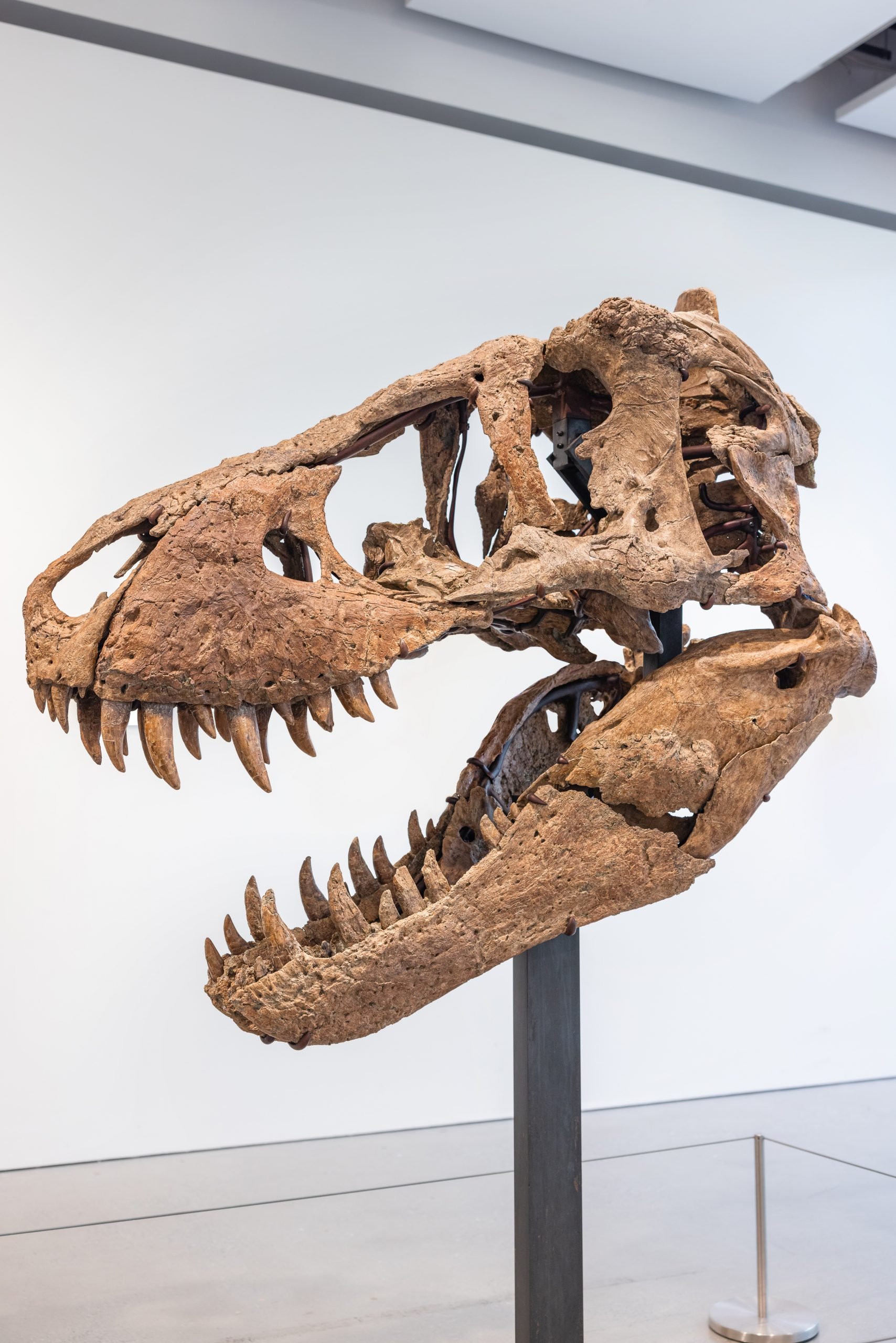
One of the most complete Tyrannosaurus rex skulls ever found will become the latest paleontological trophy to head to auction, expected to sell for $15 million to $20 million at a special single-lot sale at Sotheby’s New York on December 9.
“This T. rex fossil is an extraordinary discovery. Unearthed in one of the most concentrated areas for T. rex remains, the skull retained much of its original shape and surface characteristics with even the smallest and most delicate bones intact, with an extremely high degree of scientific integrity,” Henry Galiano, a Sotheby’s consultant for natural history, said in a statement.
The fossil hails from the Hell Creek Formation in Harding County, South Dakota—the site of more T. rex finds than anywhere else in the world.
This isn’t the first time Sotheby’s has sold the remains of a T. rex discovered at the privately owned geological formation. The first was Sue, the first dinosaur ever sold at auction, which sold for $8.3 million in 1997.
Maximus, a T. rex skull that the auction house claims is among the most complete and best-preserved specimens ever found, could fetch up to $20 million at Sotheby’s New York. Photo courtesy of Sotheby’s New York.
The skull on offer is quite large, measuring six feet and seven-and-a-half inches tall, mounted on an iron pedestal. The specimen weighs over 200 pounds and has been nicknamed Maximus, after the honorific title for Ancient Roman military commanders. The creature probably fought battles of its own—two puncture marks in the skull suggest a fight with a fellow T. rex.
There are less than 12 examples of similar quality in museum collections and none have ever come to auction, according to the house. Sotheby’s is billing the skull as “a rare and important paleontological discovery” that is “highly sought-after and instantly recognizable.”
It’s true that the Tyrannosaurus rex is a cultural phenomena, the undisputed king of the dinosaur world in the public eye, thanks in no small part to its starring role in the Jurassic Park movie franchise. But in addition to its fearsome reputation on the silver screen, the species has also been the subject of extensive scientific research by paleontologists and other experts.
Maximus, a T. rex skull that the auction house claims is among the most complete and best-preserved specimens ever found, could fetch up to $20 million at Sotheby’s New York. Photo courtesy of Sotheby’s New York.
The upcoming auction, which will not have a reserve price, follows Sotheby’s $6.1 million sale of a 77-million-year-old Gorgosaurus skeleton in July of this year.
Despite its advanced age, the fossil is remarkably intact, including the tooth-bearing jaw elements, most of the major external bones on both sides, and many of the teeth. Experts agree that all the bones came from the same creature, which makes the more skull more valuable than a composite specimen.
That the skull is in such good condition is quite remarkable. In comparison, most of the dinosaur’s body was destroyed by erosion that unearthed the skeleton.
“Without the work of experienced field paleontologists who carefully collected and preserved this skull, it may have eroded away and been lost to science forever,” Galiano said.
Maximus, a T. rex skull that the auction house claims is among the most complete and best-preserved specimens ever found, could fetch up to $20 million at Sotheby’s New York. Photo courtesy of Sotheby’s New York.
He also told Bloomberg that the lack of a body will increase the number of potential buyers: “When you think about it, more people can fit a skull in their home than people who could fit a full dinosaur.”
The winning bidder will receive documentation of the fossil’s 2020 and 2021 excavation, including field photographs, a bone inventory, and condition and authenticity reports. The current owner has chosen to remain anonymous.
Should it match the pre-sale estimate, the skull, which came from an adult dinosaur, will become one of the most expensive fossils ever to hit the block.
Maximus, a T. rex skull that the auction house claims is among the most complete and best-preserved specimens ever found, could fetch up to $20 million at Sotheby’s New York. Photo courtesy of Sotheby’s New York.
Other major recent dinosaur sales include a velociraptor skeleton that went for $12.4 million in May, and the T. rex Stan, the most expensive fossil at auction of all time, which sold for $31.8 million in 2020. Both sales took place at Christie’s New York. (The latter, also from the Hell Creek Formation, now belongs to the new natural history museum in Abu Dhabi, set to open on Saadiyat Island in 2025.)
The auction house is also holding Asia’s first auction of a full T. rex skeleton later this month, with the sale of Shen, expected to fetch $15 million to $25 million, on November 30 at Christie’s Hong Kong.
Some paleontologists have decried the recent vogue for dinosaur fossil auctions, arguing that each specimen purchased by private collectors means less access for scientists looking to study the remains of these ancient creatures.